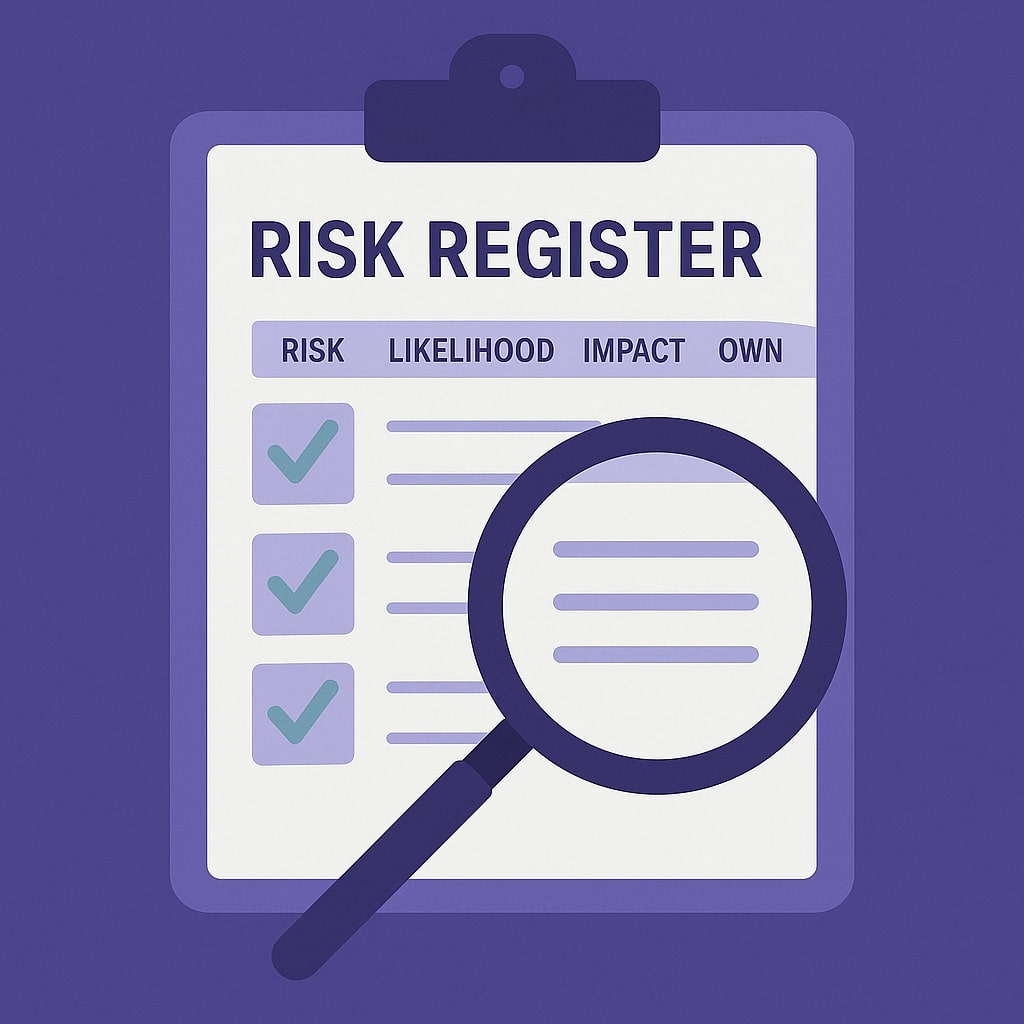If your company is growing, adding new people, tools, customers, or expanding into new markets, you’re also quietly accumulating risk. Some of that risk is obvious, like a potential data breach or a missed compliance deadline. But much of it hides in plain sight: outdated policies, unclear ownership, unsupported tools, or knowledge trapped in someone’s head.
That’s where a risk register comes in.
What Is a Risk Register?
A risk register is simply a structured way to track what could go wrong — and what you’re doing about it. It’s typically a shared document, spreadsheet, or system that helps your team log potential risks and monitor them over time.
Each entry usually includes:
A short description of the risk
How likely it is to happen
What kind of impact it would have if it did
Who owns that risk
What’s being done to prevent or reduce it
A sense of whether that risk is growing, stable, or shrinking
Think of it as a high-level snapshot of what’s worth watching and who’s keeping an eye on it.
Why It Matters (Even for Small Teams)
Small teams often assume they’ll catch risks through informal communication, in Slack, over coffee, or in spontaneous meetings. But as your company grows, that assumption breaks down. People move faster, new tools get adopted without oversight, and small issues snowball into big ones.
A risk register brings structure to the chaos. It helps teams spot blind spots early, align on priorities, and create shared accountability. In fact, documenting risks is often a foundational step when setting up a broader compliance management process, and it’s something that auditors will ask for during a compliance audit).
Specifically, it enables you to:
Spot early warning signs
Focus attention on what really matters
Make sure someone’s accountable for follow-through
Track changes over time (especially helpful during audits)
Show clients or investors that you take risk seriously
What Should You Include?
While formats vary, most risk registers are organized by type. Here are a few common categories you’ll want to track:
Compliance & Legal – things like regulatory changes, outdated contracts, or mandatory trainings that haven’t been completed
Data & Security – examples include shared logins, lack of two-factor authentication, or unapproved third-party tools
Operational – risks like a key vendor going offline, staff turnover, or undocumented internal processes
Strategic – such as overreliance on a single revenue source, or a sudden shift in your competitive landscape
Instead of generic descriptions like “security risk,” try something concrete, like “HR software lacks audit trail and 2FA.” The more specific, the more useful.. Instead of writing “IT risk,” try “no backup system for employee laptops.” The clearer your risks are, the easier it is to act on them.
Who Should Own the Risk Register?
In larger companies, the compliance officer usually manages the risk register. But in smaller teams, that responsibility often sits with operations, HR, or even finance. The key is that someone owns it, and it’s reviewed consistently.
That said, the best risk registers are built collaboratively. Every team sees different things, and input from across the company is what makes the register useful. The more distributed your organization becomes, the more important it is to document what’s at risk, and who’s watching it.
How to Start One (Without Overthinking It)
You don’t need specialized software to get started. A shared spreadsheet or document is often enough for early-stage teams.
At a minimum, create a table that includes:
The risk
Who owns it
Likelihood and impact
Mitigation steps (if any)
A place for comments or status updates
Then build a rhythm around it. Review it quarterly as a team, or anytime there’s a major change, a new product, a team restructure, or a compliance audit. Ask each department to bring one or two new risks or updates. Consistency matters more than polish. to review it as a team. Ask each department to bring 1–2 risks to the table. Keep it simple, but consistent.
Later, if you move toward certifications like ISO 27001 or SOC 2, you can integrate your register into a compliance platform.
If you’re building a broader compliance structure, a risk register is just one piece. Make sure it works in concert with your internal policies. Here’s a list of 9 company policies every business should maintain.
You might also want to revisit who owns your compliance structure. This guide to the role of a compliance officer can help clarify responsibilities as you grow.
To go deeper on how risk ties into audits, check out:
GRC-focused breakdowns by AuditBoard and Diligent
You don’t have to fear risk, but you do have to track it. A risk register gives your company structure, accountability, and foresight. It keeps everyone honest about what’s known, what’s emerging, and what’s being done.
It’s one of the simplest ways to professionalize how your business operates — and one of the easiest ways to earn trust.
Want to see how this fits into a bigger picture? Check out our guides on compliance management and compliance audits.

